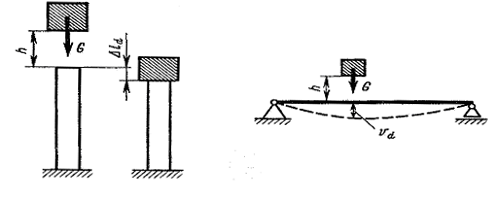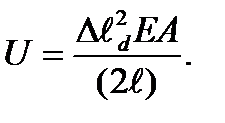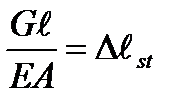Determining displacements and stresses under the impact
Consider the case of the longitudinal impact of the load on an immobile body. Let us put the load of the weight G fall from the height h on the immobile bar (Fig. 10.3 a). The body velocity in the impact moment is determined by the known formula of freely falling bodies  This velocity in a very short interval of the impact time, calculated by thousandth or hundredth parts of the second, falls to zero. In consequence of the large acceleration (moderation) a considerable force of inertia arises which determines the impact action.
This velocity in a very short interval of the impact time, calculated by thousandth or hundredth parts of the second, falls to zero. In consequence of the large acceleration (moderation) a considerable force of inertia arises which determines the impact action.
However, it is difficult to derive the theoretical law of the velocity change and consequently the force of inertia. Here another way is applied, based on the approximate utilization of the energy preservation law and the following assumptions:
1) the stresses under the impact do not surpass the proportional limit so that Hooke’s law keeps its action under the impact;
2) bodies do not fall off after the impact;
3) the mass of the bar under the impact is considered small compared with the mass of the body which makes the impact and therefore it is not taken into consideration;
4) we ignore the loss of the energy part passed in the heat and the energy of the hitting bodies vibration motion. Equate the falling load work to the internal strain energy of the bar.
| a) b) |

Fig. 10.3.
The work accomplished by the weight of the falling load is as follows
 (10.5)
(10.5)
where  is the displacement at the impact point which is equal to the bar shortening. The internal strain energy in compression has the form
is the displacement at the impact point which is equal to the bar shortening. The internal strain energy in compression has the form
 (10.6)
(10.6)
From these two equations we get
 (10.7)
(10.7)
or
 (10.8)
(10.8)
Dividing all terms of this equation by EA we get
 (10.9)
(10.9)
But  is the bar shortening from the action of the statically applied load G. Then
is the bar shortening from the action of the statically applied load G. Then
 (10.10)
(10.10)
Having solved this quadratic equation about  we obtain
we obtain
 (10.11)
(10.11)
Leaving the plus sign (because  ) we get finally
) we get finally
 (10.13)
(10.13)
where  is the dynamic coefficient.
is the dynamic coefficient.
Having divided two parts of the last equation by the bar length and multiplied by the elasticity modulus E, we will pass on deformations to the stresses:
 (10.14)
(10.14)
It can be seen from these formulas that the dynamic stresses and displacements depend on the static deformation of the body subject to the impact. The more a static deformation is, the less the dynamic stress is.
That is why the gaskets (rubber, spring) are applied for the impact softening as they give large deformations.
The dynamic stresses must not surpass the critical stresses under the compressive impact to avoid buckling. The analogical forms have the formulas and for the case of the lateral bending impact but in this case exept  we have to consider the static bar deflection at the impact place -
we have to consider the static bar deflection at the impact place -  and instead of
and instead of  - the dynamic deflection
- the dynamic deflection  (Fig. 10.3 b).
(Fig. 10.3 b).
Special cases.
1. If h=0, i.e. a suddenly applied load takes place, we get 
 from the formulas (10.12) and (10.13). Under a suddenly applied load the deformations and the stresses are twice as much than under the statically action of the same load.
from the formulas (10.12) and (10.13). Under a suddenly applied load the deformations and the stresses are twice as much than under the statically action of the same load.
2. If the height h of the fall is much more the statically deformation  to determine the dynamic coefficient we get the following approximate formula:
to determine the dynamic coefficient we get the following approximate formula:
 (10.15)
(10.15)
Example. The load G=1kN from the height h=10 cm=0,1 m falls on the middle of the steel double - T profile №27 a by the span 3 m. The second moment of the section is  the section modulus is
the section modulus is  (from the tables of the profiles),
(from the tables of the profiles), 
Determine the maximum beam deflection and the maximum stresses for its cross section.
Solving. Calculate the statical beam deflection under the load
 (10.16)
(10.16)
The dynamic coefficient is
 (10.17)
(10.17)
In the given case the dynamic effect of the falling load surpasses its statical effect in 64 times.
Calculate the statically stress from load G. The maximum bending moment will be at the middle beam section:

The maximum statically stress is

The maximum dynamic stress is

It can be seen from this example how the dynamic loads are dangerous by their action. Therefore the allowable working stresses under the impact are accepted less than under the action of the statically loads.
Дата добавления: 2020-10-25; просмотров: 673;











